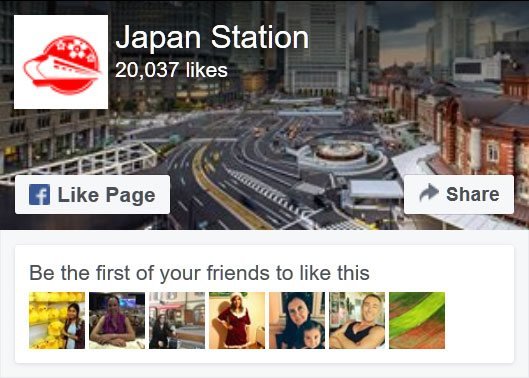Tokyo’s hippest transport, fashion and youth nexus is getting a big makeover
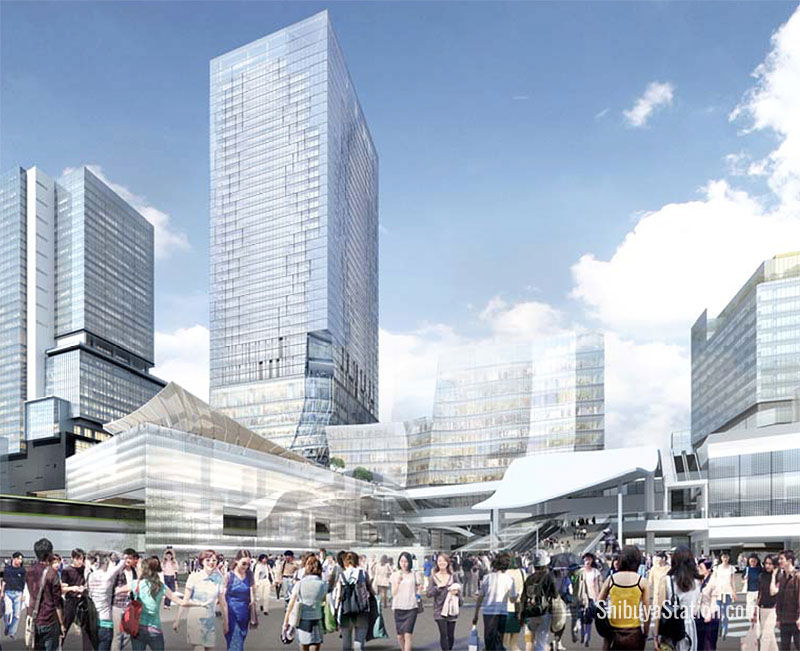
By 2027, Hachiko Square will be overshadowed by skyscrapers and a large passageway over the terminal. But where’s the Hachiko statue?
Tokyo is undergoing sweeping change in the run-up to the 2020 Olympics. New sports venues are being built, public transit systems are being upgraded and thousands of hotel rooms are being added. But one of the most remarkable projects is the redevelopment of Shibuya Station, a dense rail hub that serves countless commuters every day. Now known for its crowds and prewar statue of Hachiko the loyal dog, Shibuya is being re-engineered as an international business center for the 21st century. In the words of Shibuya Ward Mayor Ken Hasebe: “It may sound presumptuous, but I want people to think of Shibuya in the same way they do London, Paris and New York.”
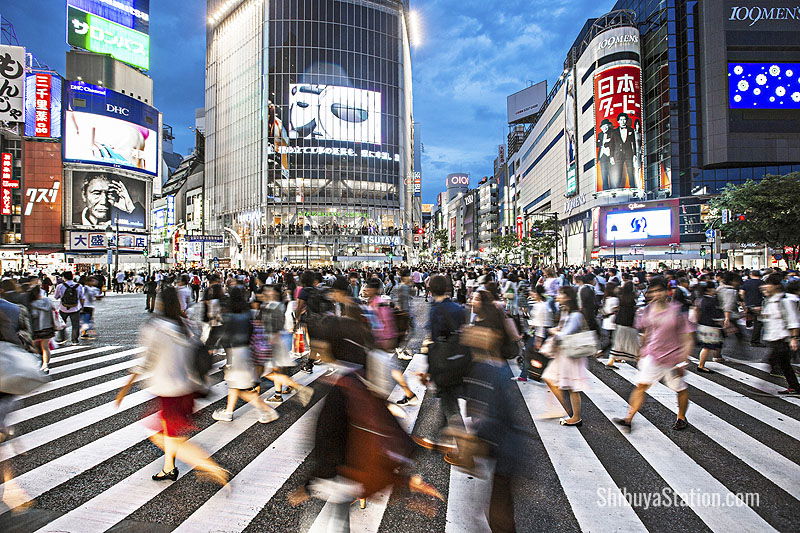
Tokyo’s answer to Times Square, Shibuya Crossing teems with thousands of people every day
Located along the western arc of the JR Yamanote loop line circling the heart of the city, Shibuya Station began in 1885 as a quaint suburban railway stop in what was once dairy farmland and tea fields. Lands to the north were home to U.S. military officials during the postwar occupation and later an athletes’ village for the 1964 Tokyo Olympics. In recent decades, the borough has been synonymous with the ever-changing fads associated with cool youth and fashionistas. It’s also known for its enormous video screens on building facades, its riot of neon signs and its packed scramble crossing – on average, nearly 3 million passengers use the station on weekdays. The total effect, with its sudden sensory overload, has often been compared to the science-fiction classic Blade Runner. The redevelopment project, however, promises to surpass cinematic fantasy as the station complex and surrounding buildings grow larger and taller while allowing even more people to throng the station and easily access all sides of it.
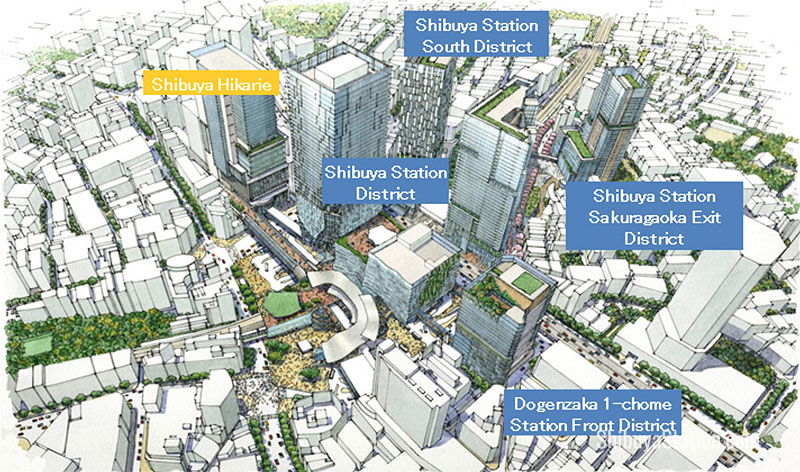
Shibuya will have four new redevelopment projects while the terminal itself gets an overhaul
The east side of Shibuya Station is already an enormous construction zone, and will continue to bustle with workers until all projects are completed in 2027. Under the aegis of Shibuya Ward, the Tokyu Corp. railway conglomerate, JR East, Tokyo Metro and other entities, four major developments – Hikarie, Shibuya Station South Area, Dogenzaka and Sakuragaoka – are planned for the area surrounding Shibuya Station as well as a rebuild of the terminal itself.
Shibuya Hikarie
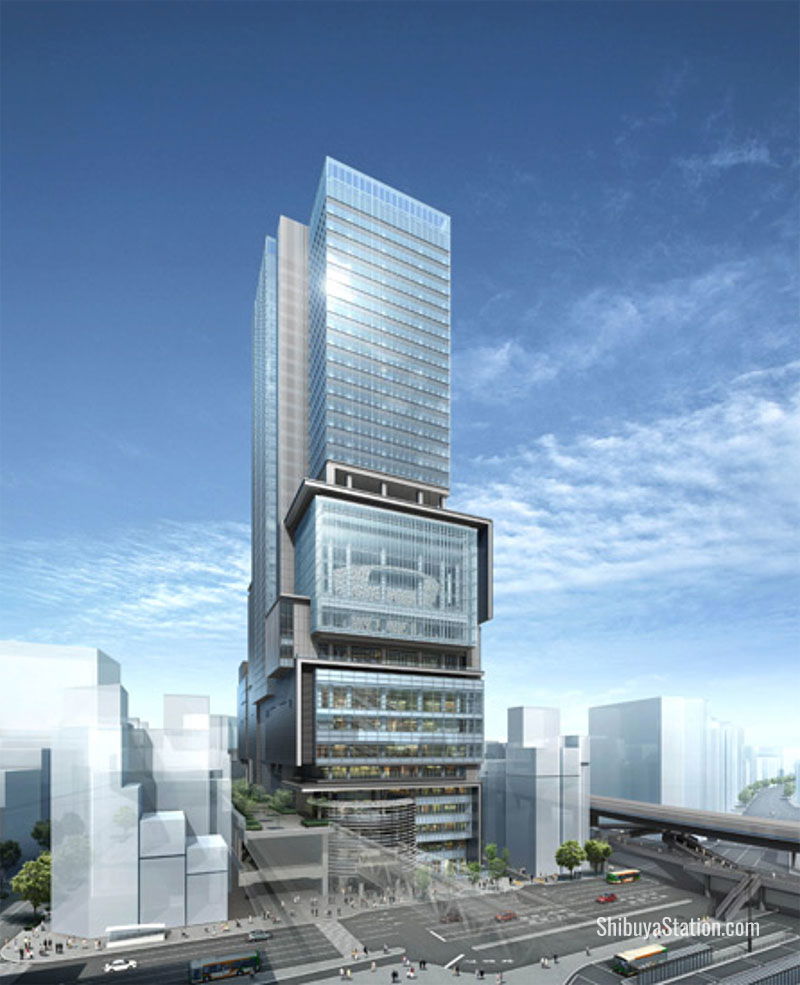
Completed in 2012, Hikarie is a shopping, office and entertainment tower on the east side of Shibuya Station
The first development is already complete: Tokyu’s Shibuya Hikarie is a 43-story, 183-meter-tall skyscraper with LED lights on its exterior. Hikarie is overlooks the east side of Shibuya Station and is connected to it via underground and aboveground passageways. The skyscraper houses offices, restaurants, eight floors of retail space, a venue for conferences and creative projects, as well as the 11th-floor Tokyu Theatre Orb, which hosts Broadway musicals and other performances.
Shibuya Station South Area
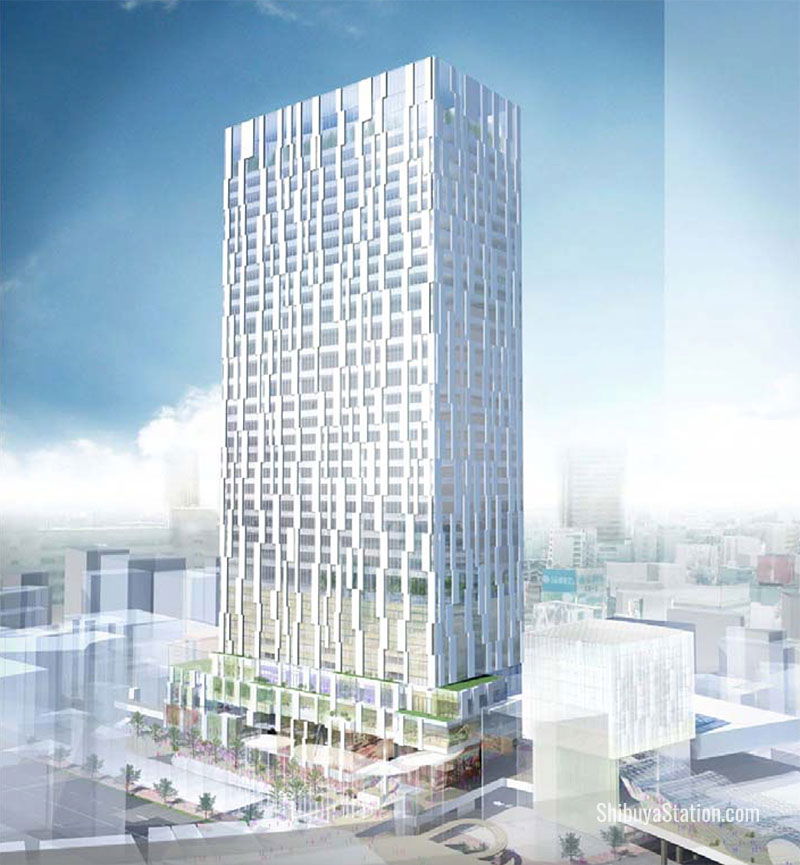
This skyscraper in the Shibuya Station South Area will serve as a bridge between the Shibuya 3-chome district and the terminal
Also on the east side of the JR Yamanote Line railway is the Shibuya Station South Area. This zone will make use of land that was occupied by the Tokyu Toyoko Line railway – which now goes underground between Shibuya and Daikanyama stations. The centerpiece of this zone is another skyscraper – 33 floors above ground and 180 meters tall. While it will mostly be office space, the building will also have a hotel, shops and space for incubating creative content startups. The structure will also serve as a bridge between Shibuya Station and the Shibuya 3-chome area, which is cut off from it by Route 246 and Meiji Dori street.
Shibuya River
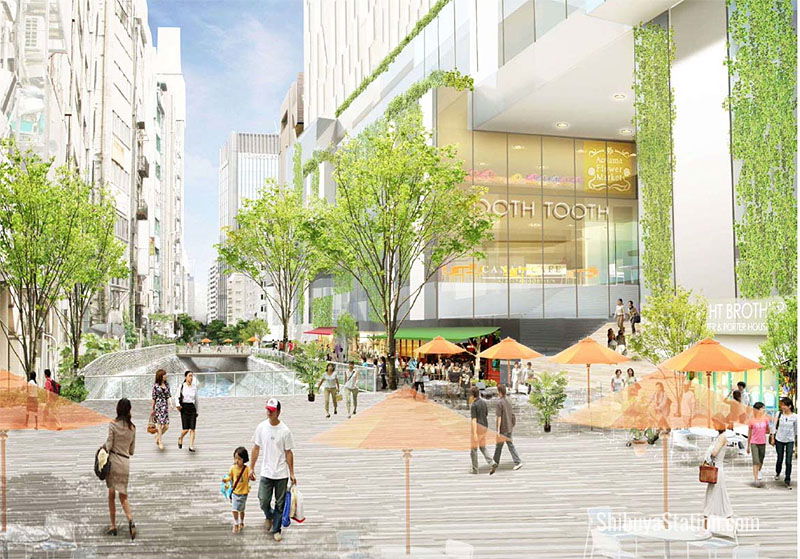
Now little more than a concrete chute, the Shibuya River will be redirected and opened up
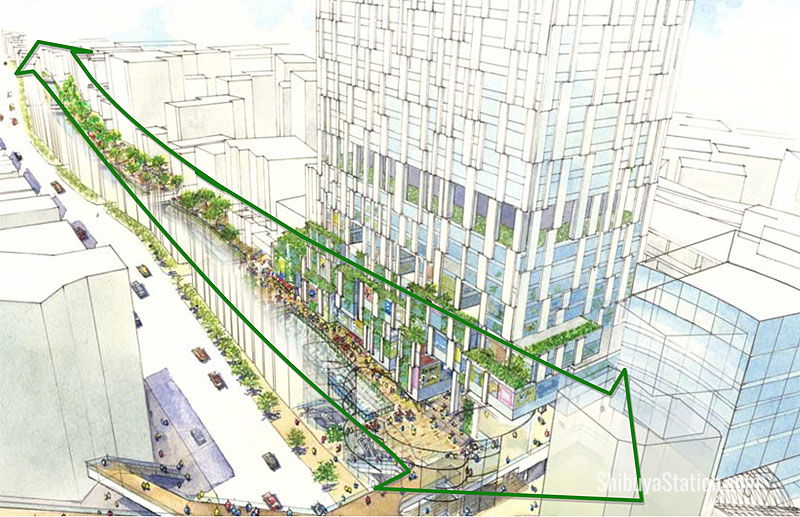
Developer Tokyu also aims to revitalize the little-known Shibuya River, currently a narrow chute behind buildings that’s lined with concrete and devoid of any greenery. The river has been diverted and a large catchment tank has been constructed for heavy rain. In an unusual move for Tokyo, the space along one part of the river will be opened up into a plaza with trees and a walkway for pedestrians. The skyscraper and surrounding area are slated to be complete in fiscal 2017, which ends in March 2018.
Shibuya Station Area
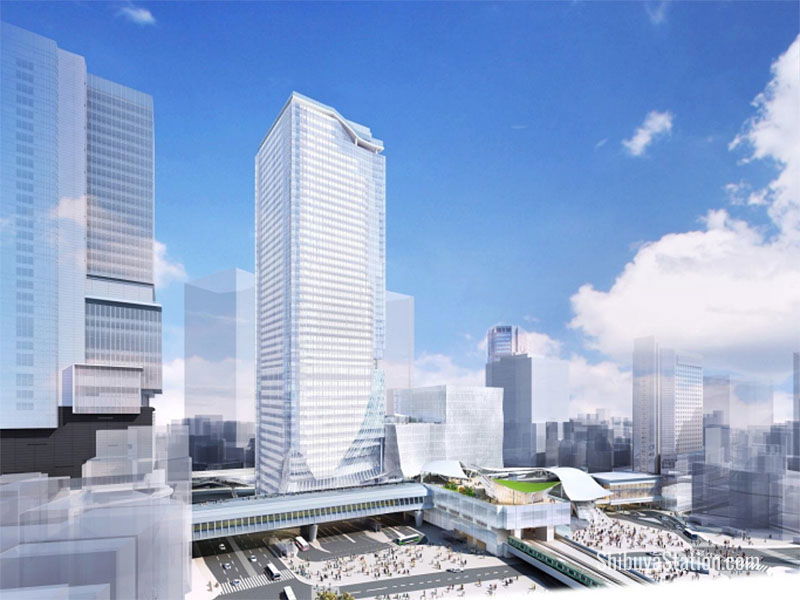
The Shibuya Station skyscraper will be the centerpiece of the new town
The pulsing heart of the neighborhood, Shibuya Station has been under construction for years already. In 2013, the Tokyu Toyoko Line connecting Shibuya with Yokohama was buried underneath Shibuya Station and connected to the Fukutoshin subway line. This allows trains to travel all the way from Yokohama to Ikebukuro, another Tokyo rail hub, and far beyond.
Observation Deck
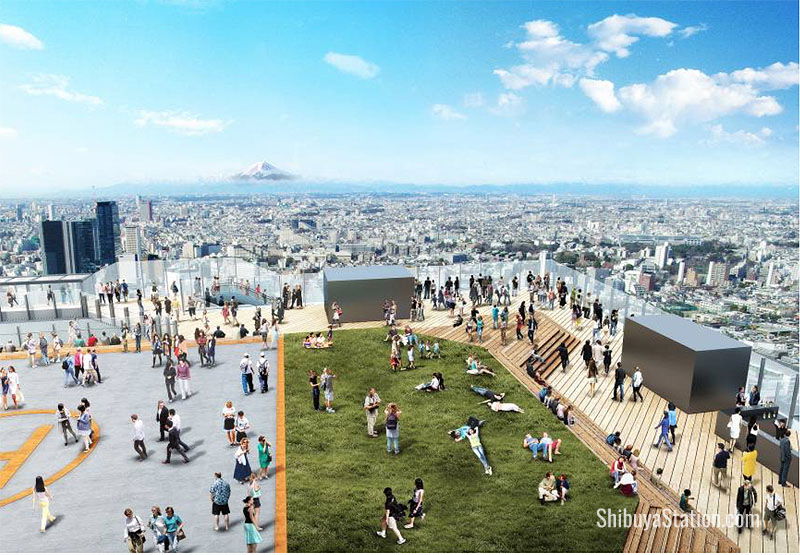
At 3,000 square meters, the rooftop observation deck will be one of Japan’s biggest
But while this transformation has brought hundreds of thousands of people through the bowels of Shibuya, another change will bring them far above the complex terminal. On a multipurpose skyscraper that will be built over the station by 2019 – just in time for the Olympics – Tokyu will open an observation deck at a height of 230 meters.
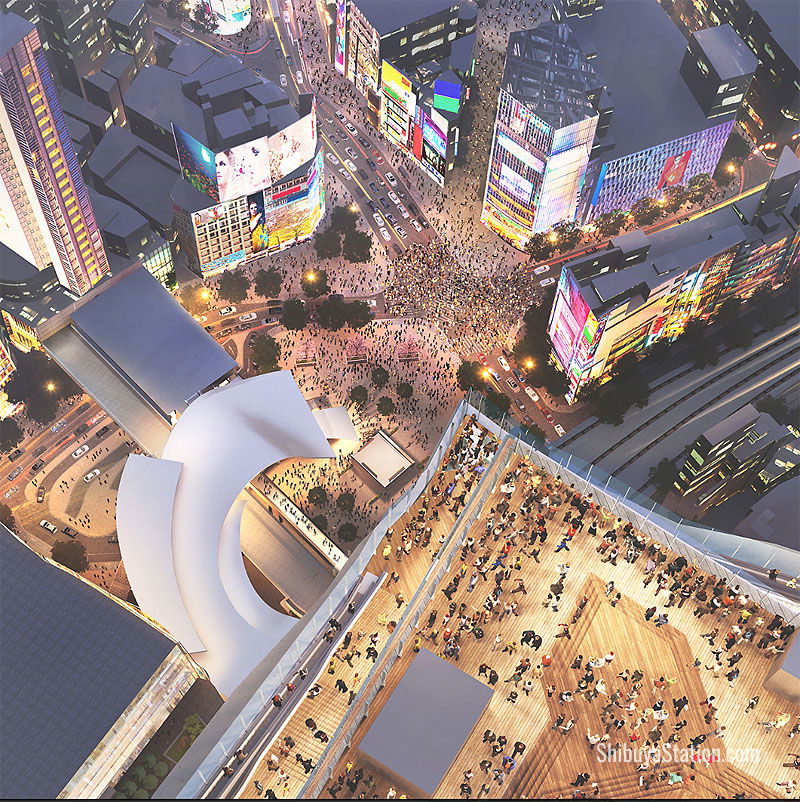
The promenade will have views of Shibuya Crossing below and the city lights

Shibuya Station Observation Deck
Visitors will be able to see the bustling intersection below as well as Tokyo Tower, Tokyo Sky Tree, Roppongi Hills and other city landmarks, as well as Mt. Fuji on clear days. At 3,000 square meters, the rooftop observation deck will be one of the largest in the country and will also feature a helipad and interior lounge for enjoying the lights of the city at night.
Other parts of Shibuya Station will also change. Parts of the main JR Shibuya Station complex will be rebuilt, the Yamanote Line will be an island platform instead of separated platforms, the Saikyo Line will be moved next to it, and the Ginza subway line will move closer to the Hikarie building.
Meanwhile, a long semicircular pedestrian passageway will connect the east and west sides of the station. It will improve the flow of people in and around the complex and sweep down into Hachiko Square under a curving roof. Of course, the statue of Hachiko will continue to have pride of place right next to it.
Dogenzaka Area
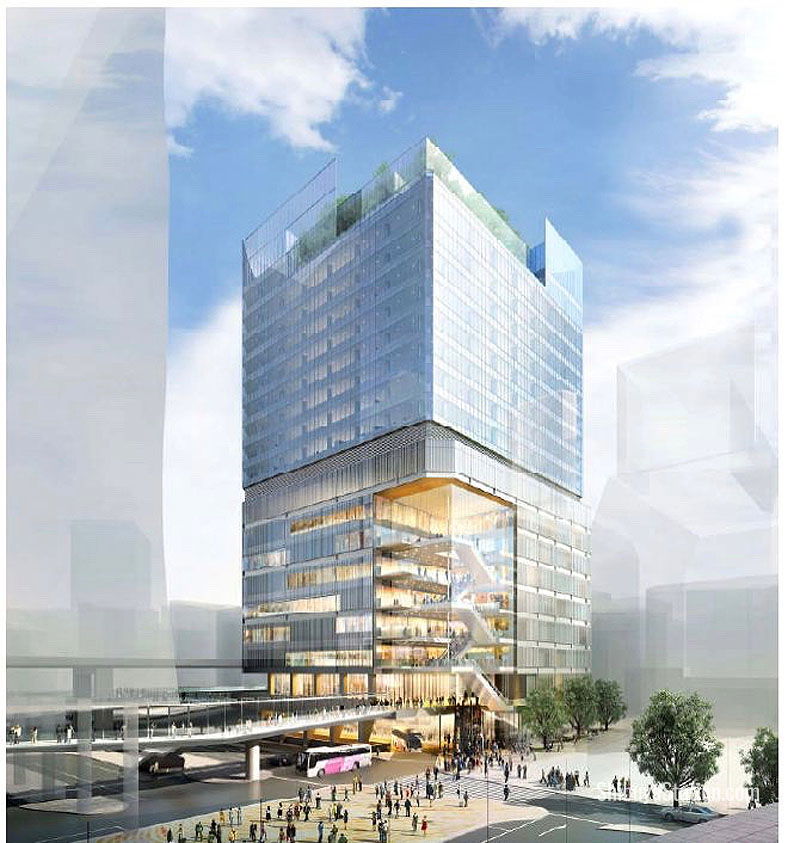
A new building in the Dogenzaka area near the Shibuya Mark City complex will have commercial and office space
On the southwestern side of Shibuya Station lies hilly Dogenzaka, a large shopping and entertainment district distinguished by Shibuya Tokyu 109, a mini-mall specializing in female fashion, and, in the back streets, the presence of many love hotels as well as live music venues. Tokyu is also planning to breathe new life into the neighborhood with a large-scale development at Dogenzaka 1-chome, located by the existing Shibuya Mark City complex, which houses shops, offices, a hotel and the terminus of the Keio Inokashira Line. While few details about it have been released so far, a new building facing the Shibuya terminal will be erected in fiscal 2018, which ends in March 2019. It will be a mixture of commercial and office space, with the project being led by Tokyu Fudosan Holdings, Tokyu Group’s real-estate arm.
Sakuragaoka Area
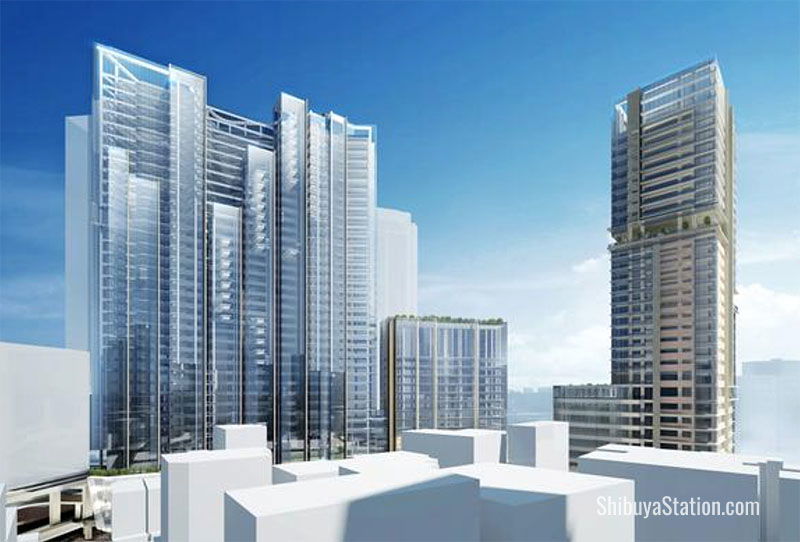
The Sakuragaoka condos and offices are targeted at foreign businesses
Located south of the station and on the west side of the Yamanote Line, the Sakuragaoka zone redevelopment will add yet more high-rise buildings to Shibuya. One will be a 180-meter tall, 36-story office tower and the other will be a 150-meter tall, 32-story condominium. Featuring multilingual medical and childcare facilities, as well as serviced apartments and a startup incubator, they will be designed to appeal to foreign companies as part of the move to rebrand Shibuya as an international hub. Construction begins in 2016 and is scheduled to wrap up in fiscal 2020, which ends in March 2021.
By the end of the decade, Shibuya will have completely changed into a nearly unrecognizable new town. But if you’re longing for the past, you might still be able to find Nonbei Yokocho (Drunkard’s Alley), a collection of tiny postwar bars by the Yamanote Line tracks that survives to this day and is proudly scruffy. The cooperative that runs it is determined to keep the establishments alive, along with the original community spirit of Shibuya.
Article by Tim Hornyak. All rights reserved.
